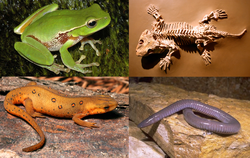
Back Amfibieë Afrikaans Amphibien ALS አምፊናል Amharic Amphibia AN برمائيات Arabic برمائيات ARZ উভচৰ প্ৰাণী Assamese Amphibia AST मेघा AWA Suda-quruda yaşayanlar Azerbaijani
| Amphibia | |
|---|---|

| |
| Clockwise from top right: Seymouria, Mexican burrowing caecilian, eastern newt and leaf green tree frog | |
| Scientific classification | |
| Domain: | Eukaryota |
| Kingdom: | Animalia |
| Phylum: | Chordata |
| Clade: | Batrachomorpha |
| Class: | Amphibia Gray 1825 |
| Subclasses | |
| |

Amphibians are members of the class Amphibia. The living ones are frogs (including toads), salamanders (including newts) and caecilians. They are four-legged vertebrates which are cold blooded.
Amphibians lay their eggs in water, usually in a foam nest. After hatching they are tadpoles, which live in the water and have gills. The tadpoles change into adults in a process called metamorphosis. When they are adult, they have lungs to breathe instead of gills, and legs. Adult amphibians also use their skin to take in oxygen, and some species of salamanders do not have lungs.
The earliest amphibians evolved in the Devonian from lobe-finned fish which had jointed leg-like fins with digits. They could crawl along the sea bottom. Some had developed primitive lungs to help them breathe air when the stagnant pools of the Devonian swamps were low in oxygen. They could also use their strong fins to hoist themselves out of the water and onto dry land if necessary.[1][2]
For tens of millions of years, during the Carboniferous and early Permian, amphibia were top predators on land, especially in the low-lying tropical river systems. In drier conditions, they were less effective, and the ancestors of mammals and reptiles (the Synapsids and Sauropsids) gradually took over the land. They laid cleidoic eggs, which had hard shells, and could be laid out of water. Most of the early large amphibians went extinct in the Triassic period; a few survived to the Lower Cretaceous.[2]
The only living amphibiana today are the Lissamphibia. These include the Anura (frogs and toads), Caudata (salamanders and newts) and Gymnophiona (caecilians). They are all rather small, compared with mammals or reptiles. The smallest frog and vertebrate in the world is the New Guinea frog (Paedophryne amauensis). The biggest amphibian is the Chinese giant salamander (Andrias davidianus).
Amphibia are found everywhere in the world, except Antarctica, and there are about 5,565 different species: 88% of them are in the Anura.[3] In number of species, they are more successful than mammals, though they occupy a smaller range of habitats. However, it is said that amphibian populations have been declining all over the world.[4] Conservation is therefore an important concern.
- ↑ Clack, Jennifer A. 2002. Gaining ground: the origin and evolution of tetrapods. Indiana University Press, Bloomington IN. ISBN 0-253-34054-3
- ↑ 2.0 2.1 Carroll, Robert 2009. The rise of amphibians: 365 million years of evolution. Baltimore: The Johns Hopkins University Press. ISBN 978-0-8018-9140-3
- ↑ Pough F.H.; et al. (2003). Herpetology. 3rd ed, Benjamin Cummings. ISBN 0131008498.
- ↑ Cite error: The named reference
declinewas used but no text was provided for refs named (see the help page).
© MMXXIII Rich X Search. We shall prevail. All rights reserved. Rich X Search